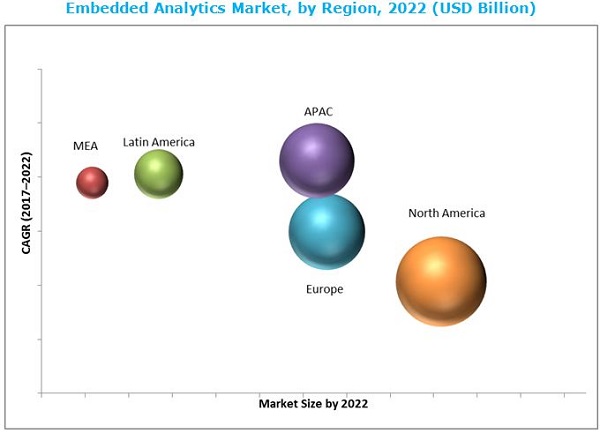Practices › Big Data & Analytics › Embedded Analytics Market
Embedded Analytics Market
The global embedded analytics market is expected to grow from USD 26.77 billion in 2017 to USD 51.78 billion by 2022 at a CAGR of 14.1% during the forecast period. In the coming years, more applications will be equipped with advanced analytics capabilities, thus driving the growth of embedded analytics market. The major drivers of the embedded analytics market are rise of data-driven organizations, higher adoption of self-service analytics, and increasing demand to integrate analytics into business applications.
Embedded analytics enables business users to access business data and analyze them at any place and any time to generate insights within an application, even though they do not have data science and analytical skills. The origin of embedded analytics lies behind the need for real-time data analysis within an application, where decision makers can have quick access to data and analytical capabilities, thus enabling them to take required actions without the need of exporting the data. Embedded analytics further adds much more value to the application. Deeper the integration of analytics into an application, more is the value of the application.
The embedded analytics market is segmented by software and service. The services segment is expected to grow at the highest CAGR between 2017 and 2022, out of which, education and training services in the professional services segment is projected to witness the highest demand, due to the growing need of embedded analytics software solutions across organizations.
The embedded analytics market in APAC is expected to grow at the highest CAGR during the forecast period. This grow is mainly driven by the increasing amount of business data and Bring Your Own Device (BYOD) across various industries in this region. Nearly half of the internet-using population resides in APAC, thereby challenging the traditional business models and BI technologies, adopted by eCommerce companies operating in this region. Companies are adopting the embedded analytics technology to quickly delve into this vast amount of data generated and gain faster business insights. Globalization and developing the economy in this region are the major drivers behind the increased adoption of embedded analytics by various companies.

Embedded analytics applications in Information Technology (IT), production, and finance business functions drive the growth of embedded analytics market
Information Technology
IT departments are responsible for system implementations, support and strategic technology acquisitions in an organization. Costs, maintenance, time-to-deploy, and user adoption are some of the key metrics needed by IT teams during purchases and reporting on the success of projects. Analytics solutions deliver crucial insights into the data – from reporting on progress at-a-glance, to detailed analysis of process optimization. With an embedded analytics solution, IT teams can have access to real-time analytics on Key Performance Indicators (KPIs), visualization of the percentage of helpdesk ticket requests resolved in the agreed time-frame to assess the success of ongoing support, in their applications itself.
Production
Production teams can benefit by embedding analytics into process monitoring for preventive maintenance to predict risk of process failure or even events that might have a negative impact on product quality. This approach can be extended to intelligent monitoring of all kinds of processes in extreme environments. For example, off-shore oil platforms use predictive analytics to prevent breakdowns of their production processes by analyzing impacts of combination of events and optimal times for intervention. Based on historical data on actions taken to fix problems of the operational oil production process, the embedded analytics predict the risk of breakdowns, pinpoint the most likely cause, and suggest the best action to fix the problem.
Finance
The finance department of any organization always relies on data accuracy and its correct interpretation. Financial departments utilize the power of analytics to determine the risk factor, enhance business processes, invest judiciously, determine the profitability, identify the target customers, and predict future events. Along with this, analytics software also assists in improving client relations, driving revenue, managing risk, meeting regulatory obligations, streamlining back office processes, and developing high quality products and services.
Human Resources
Human Resources (HR) business function deploys embedded analytics capabilities for various processes, including planning for talent acquisition, attrition risk management, and employee sentiment analysis and capacity planning. The amount of data generated in HR business application is huge and organizations are aware that employee satisfaction is vital for their success. Hence, organizations having the HR business applications have considerably leveraged embedded analytics.
Critical questions the report answers:
- Where will all these developments take the industry in the mid to long term?
- What are the upcoming industry applications for embedded analytics?
Major vendors that offer embedded analytics software and services globally are Microsoft Corporation (US), IBM Corporation (US), SAP SE (Germany), SAS Institute (US), Oracle Corporation (US), MicroStrategy Incorporated (US), Tableau Software (US), TIBCO Software (US), Birst (US), Logi Analytics (US), QlikTech International (US), Sisense (US), Information Builders (US), Open Text Corporation (Canada), and Yellowfin International (Australia). These vendors adopted various types of organic as well as inorganic growth strategies, such as new product launches, product developments, partnerships, collaborations, and mergers and acquisitions, to expand their offerings in the embedded analytics market.
To speak to our analyst for a discussion on the above findings, click Speak to Analyst
